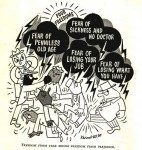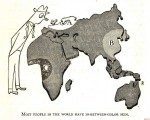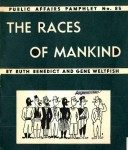Concluding commentary on Ruth Benedict and Gene Weltfish’s The Races of Mankind:
Race prejudice isn’t an old universal “instinct.” It is hardly a hundred years old. Before that, people persecuted Jews because of their religion-not their ”blood”
Jews have been treated differently because they are different, they demand to be treated differently. Their ancient cover story, which is a lie, is that the difference is just religion. Jewishness is a racial identity in the sense it is inherited, that there are distinct jewish blood lines. Jews as a group are are biologically distinct from other groups.
They will think we were crazy. “Why should race prejudice have swept the western worid,” they will say, “where no nation was anything but a mixture of all kinds of racial groups? Why did nations just at that moment begin talking about ‘the racial purity’ of their blood? Why did they talk of their wars as racial wars? Why did they make people suffer, not because they were criminals or double-crossers, but because they were Jews or Negroes or non-Nordic?”
The same reason any group of people does anything. They think it’s the RIGHT thing to do, they have different ideas WHY it is RIGHT. Some think in universal terms, others more particularist. The example here is that a variety of deceitful arguments – based on “science”, religion, etc – have been used to convince people that the RIGHT way was the way that was best for those who were afraid of being excluded.
The Russian nation has for a generation shown what can be done to outlaw race prejudice in a country with many kinds of people. They did not wait for people’s minds to change. They made racial discrimination and persecution illegal.
Reply to an Inquiry of the Jewish News Agency in the United States:
In the U.S.S.R. anti-semitism is punishable with the utmost severity of the law as a phenomenon deeply hostile to the Soviet system. Under U.S.S.R. law active anti-semites are liable to the death penalty.
J. Stalin
January 12, 1931
No part of the Russian program has had greater success than their racial program.
Yet when the USSR collapsed in 1991 it divided along racial/ethnic lines.
What Is Being Done?
In the United States a considerable number of organizations are working for democratic race equality.
Benedict and Weltfish dedicate 4-5 pages to describing the organized efforts to impose their anti-“racist” ideology on others.
The Rosenwald Foundation has sponsored southern Negro schools, elementary, high school, and college, in order to make up for the deficiencies of southern Negro education.
THE CHURCHES
. . . race superiority or inferiority are un-Christian
COMMISSION ON INTERRACIAL COOPERATION
Some information about the CIC. Commission on Interracial Cooperation, Wikipedia:
Will W. Alexander, pastor of a local white Methodist church, was head of the organization
was formed in the aftermath of violent race riots that occurred [in 1917]
In spite of its official “interracial” title, the commission was formed primarily by liberal white Southerners.
African Americans and whites had meetings to confer the African American’s problems
Commission on Interracial Cooperation, NCpedia:
with support from the Julius Rosenwald Fund
Julius Rosenwald, Wikipedia, born in 1862 to a jewish immigrant couple:
He established his Rosenwald Fund in 1917 for “the well-being of mankind.”
his fund donated over 70 million dollars to public schools, colleges and universities, museums, Jewish charities and black institutions
Back to The Races of Mankind:
BY UNIONS
when Negroes were first placed on machines previously manned by white operators, a work stoppage shut down a whole section of the Packard plant. R. J. Thomas the president of the [United Auto Workers] union, ordered the white strikers to return to work or suffer loss of union membership and employment. Within a few hours the strikers were back, with the recently promoted Negroes still at their machines.
Where “science” and argument failed the anti-Whites used threats and sanctions.
THE GOVERNMENT
The justification here was to loosen racial restrictions to maximize the workforce for the war effort, in effect not letting a good crisis go to waste.
COMMUNITY ACTIVITIES
Beaumont, Texas, similar effective action was not undertaken and a serious riot occurred.
JUST FOLKS
In the most disastrous of recent riots in Detroit, a number of obscure bystanders performed heroic actions.
From a History Channel program, Stories from the Road to Freedom, 2013:
In 1943, there were 68 racial confrontations at U.S. military bases.
Naturally. The consequences of compulsory integration were and still are disastrous and destructive for Whites. The anti-“racist” thrust in 1943 was to champion integration. The thrust today has shifted to demonizing any Whites who ever opposed or now advocate ending it.
The conclusion of The Races of Mankind sums up its purpose:
The Challenge
With America’s great tradition of democracy, the United States should clean its own house and get ready for a better twenty-first century. Then it could stand unashamed before the Nazis and condemn, without confusion, their doctrines of a Master Race. Then it could put its hand to the building of the United Nations Organization, sure of support from all the yellow and black races where the war was fought, sure that victory in this war is to be in the name, not of one race or another, but of the universal Human Race.
This was a lecture about what “we” should do, based on lies and wishful thinking. This characteristically jewish shaming and guilt-tripping has only gotten worse as Whites have ceded power in the name of equality. The equalization of non-Whites, non-Europeans, has produced ever more explicit efforts to boost non-Whites. It has all come at the expense of Whites.
As mentioned in Race and Fraud: Ruth Benedict and Gene Weltfish, United Productions of America (UPA) produced an animated cartoon based on the pamplet 1945/1946. Two versions are available on YouTube. The Brotherhood of Man – Post-WWII Animated Cartoon Against Prejudice and Racism (1946) is in color. The Brotherhood of Man (1946) is in black and white. A credit screen announces:
SPONSORED AS A CONTRIBUTION TO THE AMERICAN PEOPLE BY THE UAW-CIO
There are 4 characters:
- narrator – calm, confident, all-knowing “scientist” (jewish/communist anthropologist)
- White guy – naive optimistic rube, target of the propaganda
- green devil – paranoid, nervous, the scapegoat
- non-Whites – non-entity stereotypes, inert except to cheer on White naivete
Narrator: Everyone has his own special dream about what the world’s going to be like in the future, but we all know it’s steadily shrinking. One of these days we’re going to wake up and find the people and places we used to just read about are practically in our own back yard.
White rube: It’s happened!
Green devil: Uh unh, I don’t like the looks of this.
White rube: Why not? It’s going to be wonderful!
Green devil: Ahh, it’ll never work. We can’t get along with those people. They’re too different.
White rube: We’ll get along. We’ve got to. The future of civilization depends on brotherhood!
Non-Whites: YAYYYYYYY!
The cartoon boils the jewish anti-“racist” fraud down to its essence: Disingenuous propaganda, aimed directly at Whites, intended to convince us, even with outright lies, that we must share our societies with everyone else, and to oppose this is stupid, crazy, or evil.
Like the pamphlet, the cartoon concludes with an appeal to utopian fantasy – if “we” give “everyone” an “equal chance”, “then we can all go forward together”. The burden is placed on “we” Whites to subordinate our own best interests for benefit of everyone else.
Seventy years on, we know how this vision turns out. There is little pretense any more that “everyone” is or even should be trying to move forward together. There is no equality. The negative consequences which inevitably arise when this false ideological belief meet biological reality are constantly and consistently blamed on Whites.
Margaret Mead’s obituary for Ruth Benedict in American Ethnography Quasimonthly, 1948:
The small pamphlet, Races of Mankind, which she wrote with Gene Weltfish, went into millions of copies, was translated into film, and film script and cartoon forms, and has proved perhaps the most important single translation into genuine popular education of the many years of careful research on race differences to which anthropologists have made a major contribution.
I couldn’t fit this into the podcast, but I think it’s worth considering this epitome of jewish/communist fraud concerning race that we’ve examined in detail for these past four installments, and contrasting it with White anthropolgy, before it was derailed, as typified by this article, also titled The Races of Mankind, written by Edward Tylor and published in the July 1881 issue of Popular Science Monthly.
These excerpts illustrate a clear and objective understanding of race, sixty years before the WWII-era propaganda calculated to sow doubt and confusion about it:
ANTHROPOLOGY finds race-differences most clearly in stature and proportions of limbs, conformation of the skull and the brain within, characters of features, skin, eyes, and hair, peculiarities of constitution, and mental and moral temperament.
In comparing races as to their stature, we concern ourselves not with the tallest or shortest men of each tribe, but with the ordinary or average-sized men who may be taken as fair representatives of their whole tribe.
It thus appears that a race is a body of people comprising a regular set of variations, which center round one representative type. In the same way a race or nation is estimated as to other characters.
The people whom it is easiest to represent by single portraits are uncivilized tribes, in whose food and way of life there is little to cause difference between one man and another, and who have lived together and intermarried for many generations.
It is not enough to look at a race of men as a mere body of people happening to have a common type or likeness. For the reason of their likeness is plain, and indeed our calling them a race means that we consider them a breed whose common nature is inherited from common ancestors. Now, experience of the animal world shows that a race or breed, while capable of carrying on its likeness from generation to generation, is also capable of varying.
As the influence and power of jews increased, jewish views on race came to prevail. False uncertainty transformed gradually into outright condemnation. Social Evolutionism, Anthropological Theories – Department of Anthropology – The University of Alabama:
[Marvin] Harris called Morgan and Tylor racists (1968:137,140), but they were some of the great thinkers of their time. Today, students continue to learn Tylor’s definition of culture and all cultural anthropology classes discuss Morgan’s stages of development. These men got the ball rolling in terms of anthropological theory.
Marvin Harris is on the Jews in Anthropology short list.
The podcast will be broadcast and available for download on Tuesday at 9PM ET.
Podcast: Play in new window | Download















